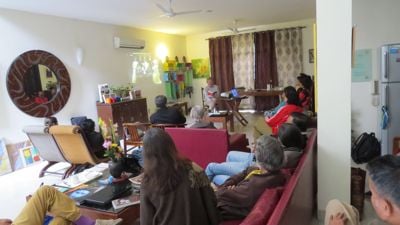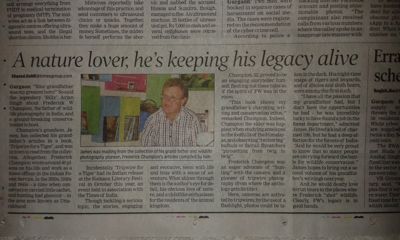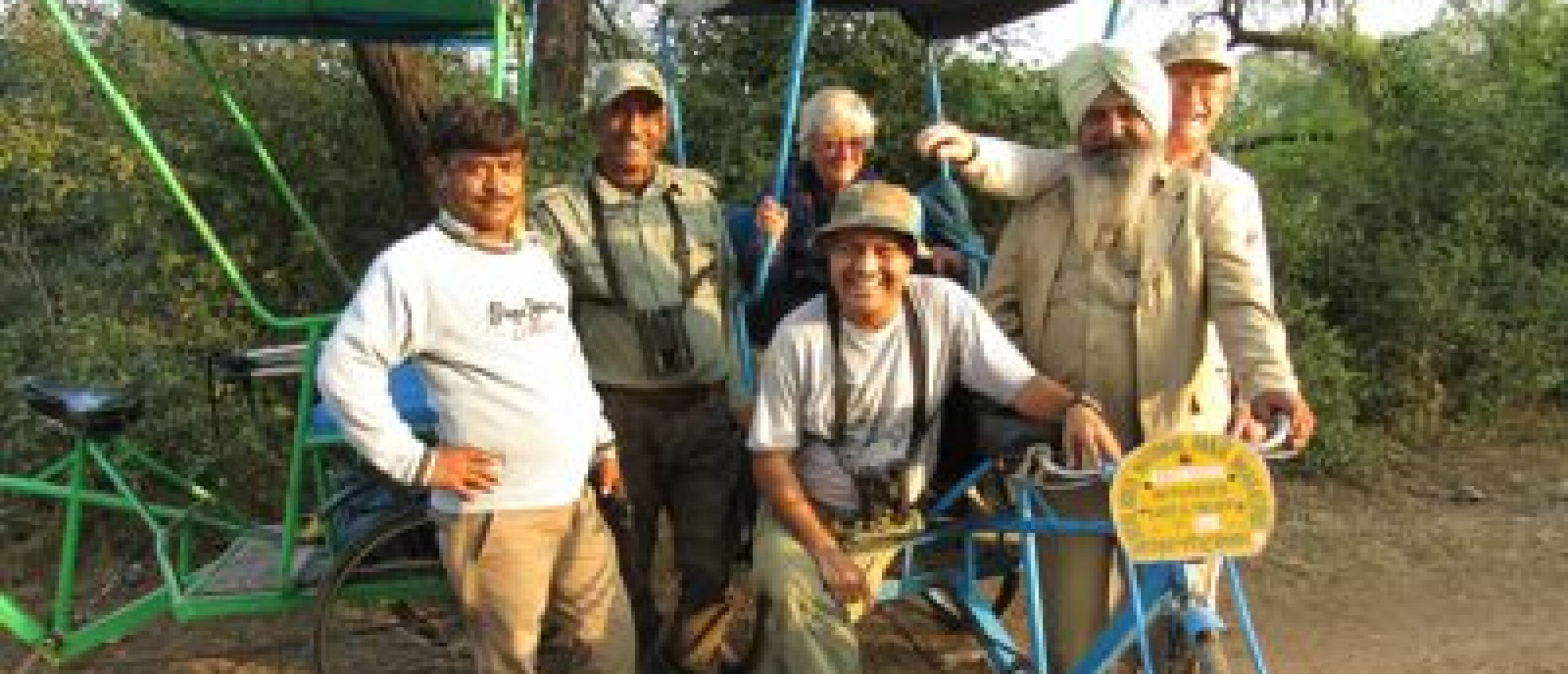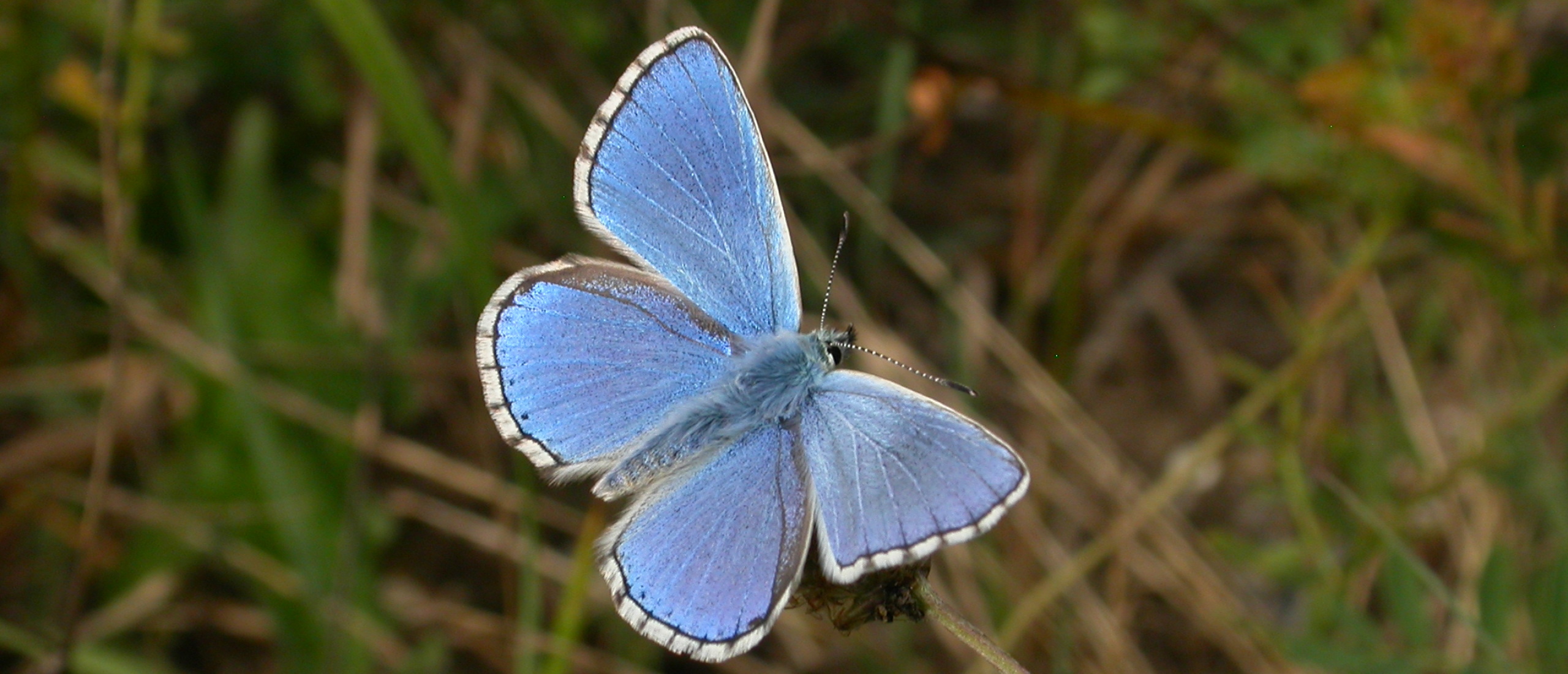
Bharatpur to Gurgaon, the end of the story...and a new beginning Following our stay in the Birders' Inn at Bharatpur and the Indian Skimmer day at the Chambal River, the final stage of Rosemary's and my Great Indian Adventure of 2015 began. We were transported by driver Maharaj Singh to Gurgaon, a booming, chaotic new town to the west of Delhi, with enormous apartment blocks springing up everywhere, intermingled with unmade up roads and dusty vacant lots awaiting development. Our accommodation, by contrast, was in a quiet gated community, an oasis of relative calm shut off from the maelstrom outside. I always find it strange being in such a place. On the one hand it is pleasant to be cushioned from the madding crowd outside, but if one has no vehicle, the possibilities for escape are very limited indeed. On one occasion I became a little desperate, and decided to walk out of the campus and attempt to cross the dual carriageway and visit a shopping mall on the other side. I got halfway, and then became totally trapped on the central reservation between the two streams of swirling, honking traffic. It seemed to be impossible to go forward, and impossible to return. Finally, I followed the example of two elderly pedestrians and literally launched myself into the traffic, and luckily the thundering trucks and rushing cars drove around me. It was not worth it though; the shopping mall was filled with vacant spaces and boarded up, empty lots. After a day spent recovering from the rigours of our 3.5-month journey, the next morning saw us being driven to the nearby home of our hosts Shilpi Singh and Manish Sinha for a book reading. Although they had only started publicising this event a few days previously, there was a good turn-out, and it was again a huge privilege for me to have the opportunity to introduce a new audience to the magic of my grandfather F W Champion's evocative writings, which clearly still have the power to enthrall even a young and urban audience. It was an honour also to reacquaint myself with Bikram Grewal, one of India's top ornithological writers, in whose beautiful home Shaheen Bagh/Walterre near Dehradun my parents, cousin Be and I had stayed in 2006, and Rosemary and I last year.
 It was a pleasure to introduce my grandfather's writings to a new audience
It was a pleasure to introduce my grandfather's writings to a new audience
One of the aspects of my grandfather's writings that has come more and more to my attention as I do these readings is just how elegantly he always slipped in little appeals to his audience (many of whom were passionate hunters) to let the animals live and to enjoy them as living creatures, rather than as bloody carcasses or grotesquely mounted trophies.
 F W Champion's writing is still as valid today as it was in the 1920s
F W Champion's writing is still as valid today as it was in the 1920s
An example comes in an undated and apparently unpublished article of FWC's entitled "The Jungles as a Hobby", which in part deals with the debate that was then raging about the comparative merits of hunting with the rifle or with the camera, the hunters stating that photography was an effeminate and over-safe hobby: So much for camera-hunting as a sport – a sport which normally is possibly a little less dangerous than the more sporting forms of big-game hunting, but which can nevertheless be made dangerous if the photographer should so desire. But there is the more scientific side of the question. India provides a magnificent field for the study of the life-histories, the domestic habits, the characteristics of the splendid array of wild animals and birds that it contains – and it is astounding how little is known about many of these creatures. The hunter-naturalist has made many valuable observations at one time and another, but his opportunities are greatly limited because, as a rule, he is interested only in dangerous game or in record heads, and further, his object is naturally to bring his quarry to bag at the first suitable moment so that, with his first shot disappears all the beauty, all the interest of the living animal. The horns will no doubt look very fine on the walls of the Mess or the skin on the floor, but no matter how well they may be mounted, they will never give any idea of the splendour and the beauty they portrayed when carried by their rightful owner. Ironically, I could have sold a considerable number of copies of 'Tripwire for a Tiger' at this event, but as it had been planned at such short notice, there was no time to alert my publisher to send a consignment in time; she would also have been hard pushed to get the books into the post, as she is based in Chennai, which was experiencing the massive upheaval that followed the devastating floods that had hit that city just before. But it just shows what a huge untapped market there is for my grandfather's writing even today, and it gives me inordinate pleasure to enable him, even though he wrote those pieces eighty or ninety years ago and he has long since departed this world, to inspire a young audience to continue the battles for India's priceless wildlife heritage that he started so passionately.
 Reading my grandfather's evocative stories is a pleasure to do
Reading my grandfather's evocative stories is a pleasure to do
After the event, I was interviewed by Times of India journalist Sharad Kohli, and a charming article describing the event appeared in the following day's Sunday Times. The quote I liked most in the article was: 'Champion, 52 (that's me!), proved to be an engaging storyteller himself, fleshing out these tales as if the spirit of FW was in the room.'
 The event was well covered in the following day's Sunday Times
The event was well covered in the following day's Sunday Times
Our afternoon was spent in the beautiful garden and home of friends Ashima and Kumar, where we were treated to a buffet lunch looking out at the low range of hills that adjoins their property. It was a delight to find that 87-year-old Ann Wright, whom we had met a few weeks earlier at Kanha National Park, was also present, and her daughter Belinda Wright, one of the most tireless campaigners for India's tigers today, joined us later. Our hosts were proud owners of first editions, complete with dust covers, of both of my grandfather's books, and it was nice to photograph both of these together with Tripwire. I hope to produce a second volume next year (title not yet decided), featuring the remainder of his articles, followed eventually by a coffee-table volume celebrating FWC's astonishing wildlife photographs, but a publisher still needs to be found for that product.
 A unique sight: two first editions of F W Champion's books, complete with dustcovers, and Tripwire
A unique sight: two first editions of F W Champion's books, complete with dustcovers, and Tripwire
The following day, my friend Prasanna Gautam took me off on a final birding bash around the area, and we started at a wetland only a short distance away from our accommodation. This area of watery ground, with patches of open water, reeds and water hyacinth, was absolutely full of birdlife, with rafts of duck, flocks of geese, waders and amazing numbers of brightly coloured Purple Swamphens foraging busily. We were treated to a star performance by a confiding Bluethroat, which hopped ever closer to us, followed by a sighting of my final new bird for the trip, an elusive Ruddy-breasted Crake, which popped out of its reedy hideaway for just long enough to allow me to obtain a few record photographic shots. This bird brought my total to 343 species for the trip, a total which could easily have topped 400 if I had had a couple of birding days in the hills during or after the Kumaon Literary Festival back in October.
 Purple Swamphens seemed to particularly favour this doomed wetland
Purple Swamphens seemed to particularly favour this doomed wetland
 The Bluethroat hopped closer and closer
The Bluethroat hopped closer and closer
 Bluethroats are not always this confiding
Bluethroats are not always this confiding
 The Ruddy-breasted Crake popped out of its reedy hideaway for a few moments
The Ruddy-breasted Crake popped out of its reedy hideaway for a few moments
On the flanks of this productive avian paradise huge new tower blocks were rising into the sky, and I learned that the whole area is now living on borrowed time, the land having already been bought up by developers, so it will have disappeared within a short time. I realise that people need places to live, but would it not be possible to incorporate this wonderful green patch of wildlife habitat into the city plan as an urban nature reserve, as I saw years ago at the Oi Bird Park in Tokyo, and more recently at the WWT's Wetland Centre in London, which are totally surrounded by urban sprawl and yet attract large numbers of wintering birds, and provide much-loved green spaces for the urban masses?
 Prasanna Gautam birding in the Gurgaon wetland as huge apartment blocks rise in the background
Prasanna Gautam birding in the Gurgaon wetland as huge apartment blocks rise in the background
With these thoughts in mind, we drove a short distance to a much better protected wetland, the Sultanpur Wildlife Sanctuary, which is the state of Haryana's only national park. As it was a Sunday, there were large numbers of visitors, but we were still able to enjoy what were to be my last views of waterbirds during this Great Indian Adventure.
 Sultanpur really is like a tiny Bharatpur
Sultanpur really is like a tiny Bharatpur
 A female Nilgai crossing one of Sultanpur's jheels
A female Nilgai crossing one of Sultanpur's jheels
Sultanpur is a sort of poor man's Bharatpur, with large numbers of ducks, geese, herons, egrets, ibises and cormorants enjoying the marshy lakes, all easily viewable from the network of raised walkways that crisscross the reserve. A large nesting colony of Painted Storks seems to be thriving, and we were also alerted to a group of Common Cranes in flight above us by their bugling, croaking cries, as they banked to come in to land on the far side of a jheel (pond).
 Sultanpur is a protected jewel close to Delhi
Sultanpur is a protected jewel close to Delhi
 A colony of Painted Storks seems to be thriving at Sultanpur
A colony of Painted Storks seems to be thriving at Sultanpur
 Painted Storks at the nest in Sultanpur
Painted Storks at the nest in Sultanpur
A few Citrine Wagtails were pecking through the grassy lakeside vegetation. These delightful birds are even more brightly coloured than our Grey or Yellow Wagtails, and I drank in their beauty before we headed back to Gurgaon for our final night in India, at the end of what has turned out to be a highly successful tour, which will doubtless lead to many things in the not-too-distant future.
 This Citrine Wagtail was one of my last birds of this Great Indian Adventure
This Citrine Wagtail was one of my last birds of this Great Indian Adventure











